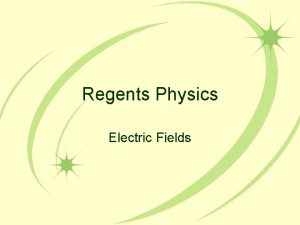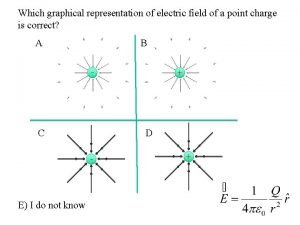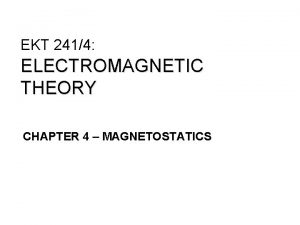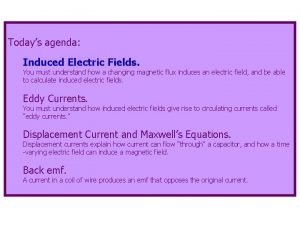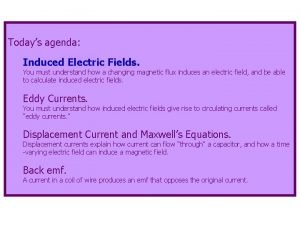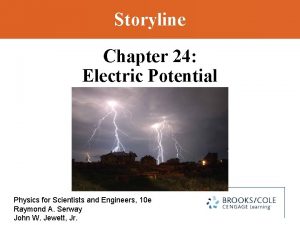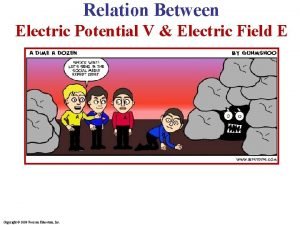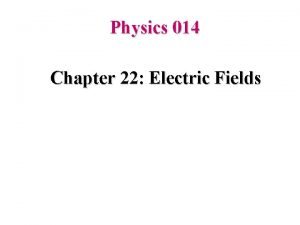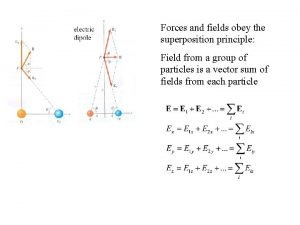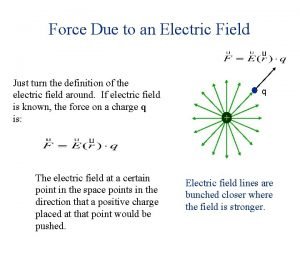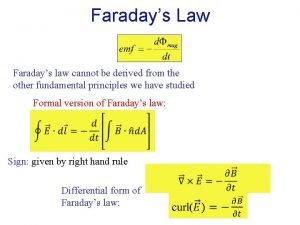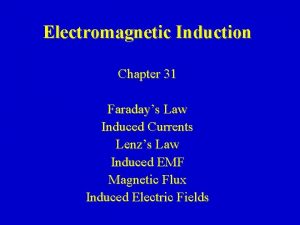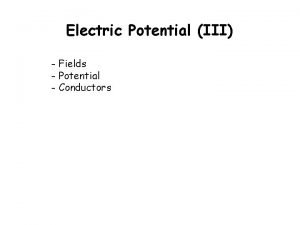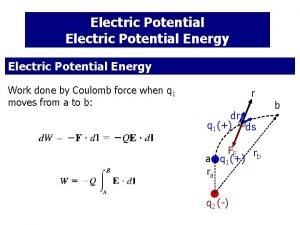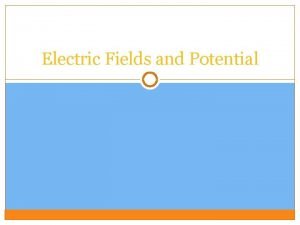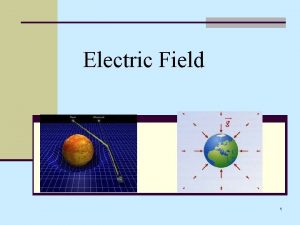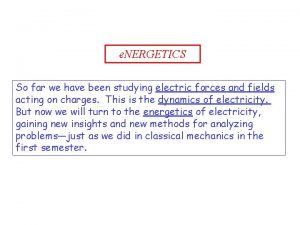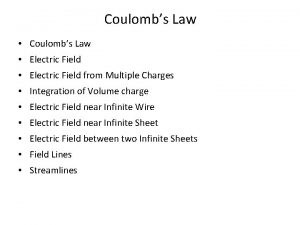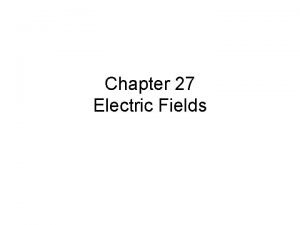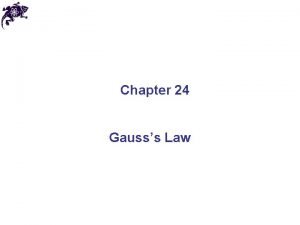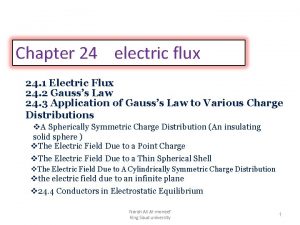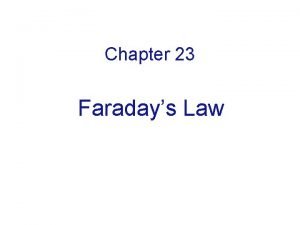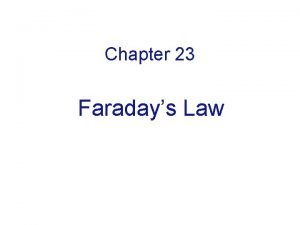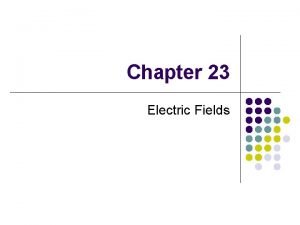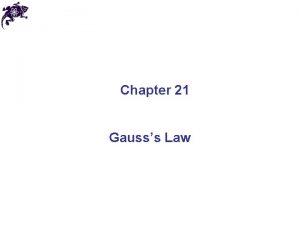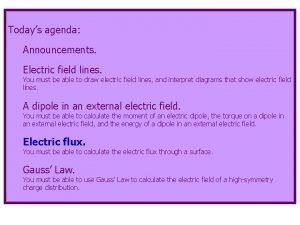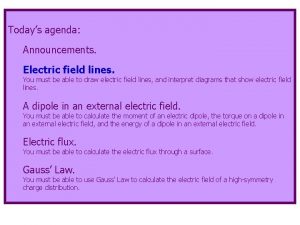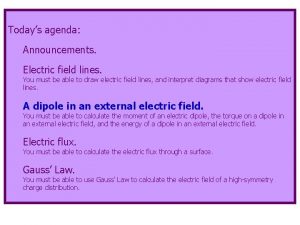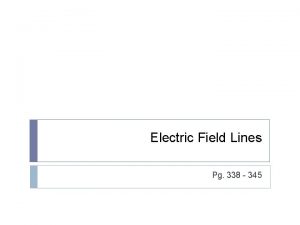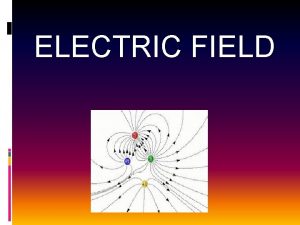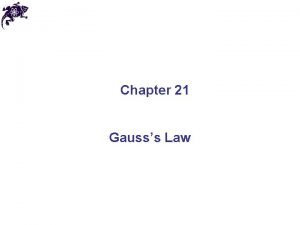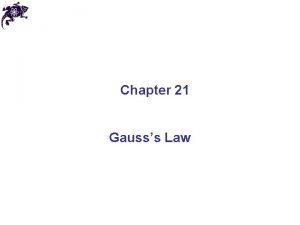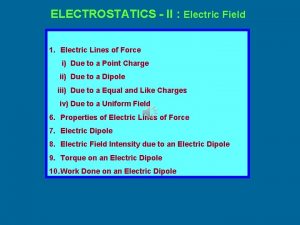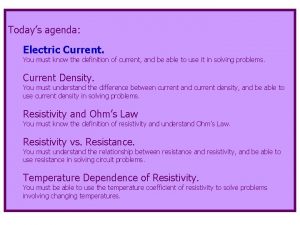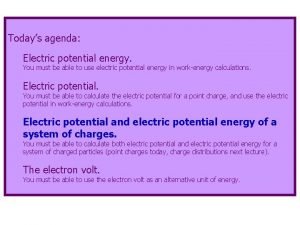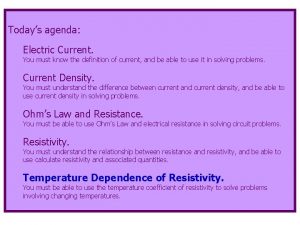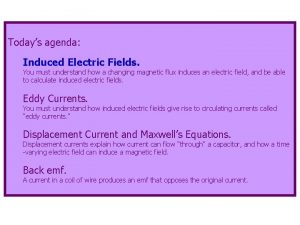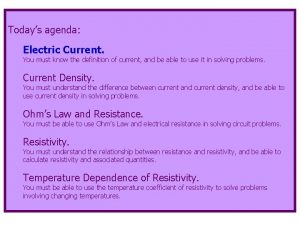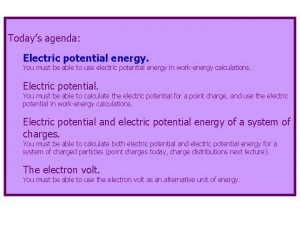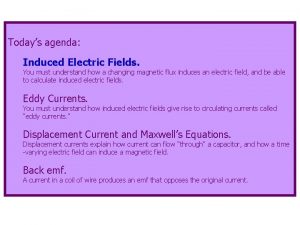Todays agenda Announcements Electric field lines You must

































































- Slides: 65

Today’s agenda: Announcements. Electric field lines. You must be able to draw electric field lines, and interpret diagrams that show electric field lines. A dipole in an external electric field. You must be able to calculate the moment of an electric dipole, the torque on a dipole in an external electric field, and the energy of a dipole in an external electric field. Electric flux. You must be able to calculate the electric flux through a surface. Gauss’ Law. You must be able to use Gauss’ Law to calculate the electric field of a high-symmetry charge distribution.

Electric Field Lines Electric field lines help us visualize the electric field and predict how charged particles would respond to the field. http: //phet. colorado. edu/sims/charges-and-fields_en. html

Electric Field Lines Example: electric field lines for isolated +2 e and -e charges.

Here’s how electric field lines are related to the field: The electric field vector E is tangent to the field lines. The number of lines per unit area through a surface perpendicular to the lines is proportional to the electric field strength in that region The field lines begin on positive charges and end on negative charges. The number of lines leaving a positive charge or approaching a negative charge is proportional to the magnitude of the charge. No two field lines can cross.

http: //www. its. caltech. edu/~phys 1/java/phys 1/EField. html This applet has issues with calculating the correct number of field lines, but the “idea” is OK. Example: draw the electric field lines for charges +2 e and -1 e, separated by a fixed distance. View from “near” the charges.

http: //www. its. caltech. edu/~phys 1/java/phys 1/EField. html This applet has issues with calculating the correct number of field lines, but the “idea” is OK. Example: draw the electric field lines for charges +2 e and -1 e, separated by a fixed distance. This time you are looking from “far away. ”

Applets illustrating motion of charged particle in electric field: http: //www. mhhe. com/physsci/physical/giambattista/electric_fields. html http: //www. nhn. ou. edu/~walkup/demonstrations/Web. Assignments/Charged. Particles 001. htm http: //phet. colorado. edu/sims/charges-and-fields_en. html

Today’s agenda: Announcements. Electric field lines. You must be able to draw electric field lines, and interpret diagrams that show electric field lines. A dipole in an external electric field. You must be able to calculate the moment of an electric dipole, the torque on a dipole in an external electric field, and the energy of a dipole in an external electric field. Electric flux. You must be able to calculate the electric flux through a surface. Gauss’ Law. You must be able to use Gauss’ Law to calculate the electric field of a high-symmetry charge distribution.

Electric Dipole in an External Electric Field An electric dipole consists of two charges +q and -q, equal in magnitude but opposite in sign, separated by a fixed distance d. q is the “charge on the dipole. ” Earlier, I calculated the electric field along the perpendicular bisector of a dipole (this equation gives the magnitude only). Caution! This is not the general expression for the electric field of a dipole! The electric field depends on the product qd. This is true in general.

q and d are parameters that characterize the dipole; we define the "dipole moment" of a dipole to be the vector caution: this p is not momentum! where the direction of p (as well as d) is from negative to positive (NOT away from +). +q -q p To help you remember the direction of p, this is on your equation sheet:

A dipole in a uniform electric field experiences no net force, but probably experiences a torque. Noooo! No torques!

A dipole in a uniform electric field experiences no net force, but probably experiences a torque… p F- -q +q There is no net force on the dipole: F+ E

p ½ d sin F- -q +q F+ E ½ d sin If we choose the midpoint of the dipole as the origin for calculating the torque, we find and in this case the direction is into the plane of the figure. Expressed as a vector, Recall that the unit of torque is N·m, which is not a joule!

p ½ d sin F- -q +q F+ E ½ d sin The torque’s magnitude is p E sin and the direction is given by the right-hand rule. What is the maximum torque magnitude? For what angle is the torque a maximum?

Energy of an Electric Dipole in an External Electric Field p F- -q +q F+ E If the dipole is free to rotate, the electric field does work* to rotate the dipole. The work depends only on the initial and final coordinates, and not on how you go from the initial to the final coordinates. *Calculated using , which you learned in Physics 1135.

Does that awaken vague memories of Physics 1135? If a force is conservative, you can define a potential energy associated with it. What kinds of potential energies did you learn about in Physics 1135? Because the electric force is conservative, we can define a potential energy for a dipole. The equation for work suggests we should define

+q p F+ E F- -q With this definition, U is zero* when = /2. *Remember, zero potential energy does not mean minimum potential energy!

+q p F+ E -q F- U is maximum when cos =-1, or = (a point of unstable equilibrium*). *An small change of away will result in rotation.

-q F- =0 p E +q F+ U is minimum when cos =+1, or =0 (stable equilibrium*). *An small change of away 0 will result in rotation back towards = 0.

p F- -q +q F+ E With this definition, U is zero when = /2. U is maximum when cos =-1, or = (a point of unstable equilibrium). U is minimum when cos =+1, or =0 (stable equilibrium). It is “better” to express the dipole potential energy as Recall that the unit of energy is the joule, which is a N·m, but is not the same as the N·m of torque!

Summary: Units are N·m, but not joules! Units are N·m = joules! p +q E -q The information on this slide is enough to work homework problems involving torque.

Today’s agenda: Announcements. Electric field lines. You must be able to draw electric field lines, and interpret diagrams that show electric field lines. A dipole in an external electric field. You must be able to calculate the moment of an electric dipole, the torque on a dipole in an external electric field, and the energy of a dipole in an external electric field. Electric flux. You must be able to calculate the electric flux through a surface. Gauss’ Law. You must be able to use Gauss’ Law to calculate the electric field of a high-symmetry charge distribution.

Electric Flux We have used electric field lines to visualize electric fields and indicate their strength. We are now going to count* the number of electric field lines passing through a surface, and use this count to determine the electric field. *There are 3 kinds of people in this world: those who can count, and those who can’t. E

The electric flux passing through a surface is the number of electric field lines that pass through it. Because electric field lines are drawn arbitrarily, we quantify electric flux like this: E=EA, A E …except that… If the surface is tilted, fewer lines cut the surface. Later we’ll learn about magnetic flux, which is why I will use the subscript E on electric flux. E The green lines miss!

We define A to be a vector having a magnitude equal to the area of the surface, in a direction normal to the surface. A E The “amount of surface” perpendicular to the electric field is A cos . Therefore, the amount of surface area effectively “cut through” by the electric field is A cos . AEffective = A cos so E = EAEffective = EA cos . Remember the dot product from Physics 1135?

If the electric field is not uniform, or the surface is not flat… divide the surface into infinitesimal surface elements and add the flux through each… A d. A E a surface integral, therefore a double integral Remember, the direction of d. A is normal to the surface.

If the surface is closed (completely encloses a volume)… …we count* lines going out as positive and lines going in as negative… E d. A a surface integral, therefore a double integral For a closed surface, d. A is normal to the surface and always points away from the inside. *There are 10 kinds of people in this world: those who can count in binary, and those who can’t.

What the *!@* is thing? Nothing to panic about! The circle just reminds you to integrate over a closed surface.

Question: you gave me five different equations for electric flux. Which one do I need to use? Answer: use the simplest (easiest!) one that works. Flat surface, E A, E constant over surface. Easy! Flat surface, E not A, E constant over surface. Surface not flat, E not uniform. Avoid, if possible. This is the definition of electric flux, so it is on your equation sheet. Closed surface. The circle on the integral just reminds you to integrate over a closed surface. If the surface is closed, you may be able to “break it up” into simple segments and still use E=E·A for each segment.

A note on terminology… For our purposes, a vector is constant if its magnitude and direction do not change with position or time. The electric field is a vector field, so a constant electric field is one that does not change with position or time. Because the electric field can extend throughout space, we use the term “uniform electric field” to describe an electric field that is constant everywhere in space and time. A “uniform electric field” is like a “frictionless surface. ” Useful in physics problems, difficult (impossible? ) to achieve in reality. In Physics 2135, you can use the terms “constant electric field” and “uniform electric field” interchangeably.

Electric Flux Example: Calculate the electric flux through a cylinder with its axis parallel to the electric field direction. E To be worked at the blackboard in lecture…

Electric Flux Example: Calculate the electric flux through a cylinder with its axis parallel to the electric field direction. E I see three parts to the cylinder: The left end cap. E d. A

Electric Flux Example: Calculate the electric flux through a cylinder with its axis parallel to the electric field direction. E I see three parts to the cylinder: The tube. E

Electric Flux Example: Calculate the electric flux through a cylinder with its axis parallel to the electric field direction. E I see three parts to the cylinder: The right end cap. E d. A

Let’s separately calculate the contribution of each part to the flux, then add to get the total flux. The left end cap. E d. A The tube. The right end cap. E E d. A

The left end cap. E d. A Every d. A on the left end cap is antiparallel to E. The angle between the two vectors is 180 E is uniform, so

The tube. E E Let’s look down the axis of the tube. E is pointing at you. d. A Every d. A is radial (perpendicular to the tube surface). E The angle between E and d. A is 90. d. A

E The angle between E and d. A is 90. d. A The tube contributes nothing to the flux!

The right end cap. E d. A Every d. A on the right end cap is parallel to E. The angle between the two vectors is 0 E is uniform, so

The net (total) flux Assuming a right circular cylinder. * The flux is zero! Every electric field line that goes in also goes out. *We will see in a bit that we don’t have to make this assumption.

E The net electric flux through a closed cylindrical surface is zero.

+ - E If there were a + charge inside the cylinder, there would be more lines going out than in. If there were a - charge inside the cylinder, there would be more lines going in than out… …which leads us to…

Today’s agenda: Announcements. Electric field lines. You must be able to draw electric field lines, and interpret diagrams that show electric field lines. A dipole in an external electric field. You must be able to calculate the moment of an electric dipole, the torque on a dipole in an external electric field, and the energy of a dipole in an external electric field. Electric flux. You must be able to calculate the electric flux through a surface. Gauss’ Law. You must be able to use Gauss’ Law to calculate the electric field of a high-symmetry charge distribution.

Gauss’ Law Mathematically*, we express the idea of the last two slides as Gauss’ Law Always true, not always useful. We will find that Gauss’ law gives a simple way to calculate electric fields for charge distributions that exhibit a high degree of symmetry… …and we will save more complex charge distributions for advanced classes. *“Mathematics is the Queen of the Sciences. ”—Karl Gauss

Example: use Gauss’ Law to calculate the electric field from an isolated point charge q. To be worked at the blackboard in lecture…

Example: use Gauss’ Law to calculate the electric field from an isolated point charge q. E Let’s assume the point charge is +. The electric field everywhere points away from the charge. +q If you go any distance r away from +q, the electric field is always directed “out” and has the same magnitude as the electric field at any other r. What is the symmetry of the electric field? If you answered “spherical, ” treat yourself to some ice cream.

Example: use Gauss’ Law to calculate the electric field from an isolated point charge q. E To apply Gauss’ Law, we really want to pick a surface for which we can easily evaluate +q That means we want to everywhere be either parallel or perpendicular to the surface. Let’s see, for what kind of surface would this sphericallysymmetric electric field always be parallel or perpendicular? If you answered “a sphere” buy yourself some chocolate syrup to go on your ice cream.

Example: use Gauss’ Law to calculate the electric field from an isolated point charge q. E So let’s draw a Gaussian sphere of radius r, enclosing and centered on +q. “Centered on” makes it easy to evaluate +q r d. A Everywhere on the sphere, constant so are parallel and E is You do know the formula for Asphere, don’t you? If not, make sure you can find it on the OSE sheet.

Example: use Gauss’ Law to calculate the electric field from an isolated point charge q. E The charge enclosed by my Gaussian sphere is q, so +q r d. A The direction of is shown in the diagram. Or you can say is “radially out. ”

Example: use Gauss’ Law to calculate the electric field from an isolated point charge q. E “But wait, ” you say, “the parameter r does not appear in the problem statement, so it can’t appear in the answer. *” Wrong! The problem statement implies you should calculate as a function of r. *r does not appear to be a “system parameter. ” +q r

Example: use Gauss’ Law to calculate the electric field from an isolated point charge q. E “But wait, ” you say, “you already gave us the equation for the electric field of a point charge. We haven’t learned anything new. It was a lot of work for nothing. ” +q r Wrong! You have learned how to apply Gauss’ Law. You might find this technique useful on a future test. You could use a cube instead of a sphere for your Gaussian surface. The flux would be the same, so the electric field would be the same. But I don’t recommend that because the flux would be more difficult to calculate.

Homework Hint! For tomorrow’s homework, you may not apply the equation for the electric field of a point charge to a distribution of charges. Instead, use Gauss’ Law. Later I may give you permission to use the point charge equation for certain specific charge distributions. You may recall that I said you could use distributions. But I never said you could use for spherically-symmetric charge

Strategy for Solving Gauss’ Law Problems Select a Gaussian surface with symmetry that “matches” the charge distribution. Use symmetry to determine the direction of on the Gaussian surface. You want to be constant in magnitude and everywhere perpendicular to the surface, so that … … or else everywhere parallel to the surface so that . Evaluate the surface integral (electric flux). Determine the charge inside the Gaussian surface. Solve for E. Don’t forget that to completely specify a vector, your answer must contain information about its direction.

Example: calculate the electric field for 0<r< for an insulating spherical shell of inner radius a, outer radius b, and with a uniform volume charge density spread throughout shell. Note: if a conductor is in electrostatic equilibrium, any excess charge must lie on its surface (we will study this in more detail next time), so for the charge to be uniformly distributed throughout the volume, the object must be an insulator. To be worked at the blackboard in lecture…

Example: calculate the electric field for 0<r< for an insulating spherical shell of inner radius a, outer radius b, and with a uniform volume charge density spread throughout shell. Before I can choose a Gaussian surface, I need to have a clear picture of the charge distribution. Draw a spherical shell. Drawn is a 2 D slice through the center of the 3 D sphere. a b A uniform volume charge density is distributed throughout the shell. Let’s indicate this in the diagram. The inner radius is a and the outer radius is b.

Example: calculate the electric field for 0<r< for an insulating spherical shell of inner radius a, outer radius b, and with a uniform volume charge density spread throughout shell. I see three different regions: 0<r<a, a<r<b, and r>b. We should do each region separately. What is the symmetry of the charge distribution? a b This time you don’t get ice cream for answering “spherical, ” but if you said something else, ask for help with this in the Physics Learning Center.

Example (First Part): calculate the electric field for 0<r<a. For 0<r<a, draw a Gaussian sphere of radius r<a, centered on the center of the shell. r How much charge is enclosed by the sphere? qenclosed=0. Unless is some kind of pathological function, the only way for the integral to be zero is if

Example (First Part): calculate the electric field for 0<r<a. So for 0<r<a, “But wait, ” you say, “there is a whole bunch of charge nearby. How can the electric field possibly be zero anywhere? ” r Answer #1: Gauss’ Law says the field has to be zero. Are you questioning Gauss, one of the three greatest mathematicians (along with Aristotle and Newton) ever to live? Answer #2: Pick any charge on the shell. Assume a positive charge so you can draw an electric field line. Draw an electric field line from the charge out to infinity. The line never goes into the sphere (and if it did, it would go out anyway, because there is no - charge to “land on”). It contributes nothing to the flux.

Example (Second Part): calculate the electric field for a<r<b. For a<r<b, draw a Gaussian sphere of radius a<r<b, centered at the center of the shell. Let’s assume is positive, so that I have a direction to draw the electric field. A negative just reverses the direction of the electric field. E >0 a b r The charge distribution is spherically symmetric (you see the “same” thing at any given r). Therefore you must see the same electric field at any given r, so the electric field is also spherically symmetric. A spherically symmetric electric field is everywhere radial and has the same magnitude at any given r. For >0, is “out. ”

Example (Second Part): calculate the electric field for a<r<b. E Everywhere on the sphere, are parallel and E is constant so >0 a b r d. A That was easy so far, wasn’t it. The hard part is finding qenclosed. We have to determine the charge inside the dashed-line Gaussian sphere. The volume charge density is . The amount of charge in a volume V is simply V.

Example (Second Part): calculate the electric field for a<r<b. The charge enclosed by the dashed-line Gaussian sphere is the total charge on a spherical shell of inner radius a and outer radius r. >0 a b r Notice it doesn’t matter how large b is. It’s only the charge inside r that counts.

Example (Second Part): calculate the electric field for a<r<b. Finishing… >0 a b r Above is the magnitude E, the direction is radially out. We still need to calculate the electric field for r>b.

Example (Third Part): calculate the electric field for r>b. E >0 a b r This is just Q/4 0 r 2, like a point charge. d. A

Summary: electric field for 0<r< for an insulating spherical shell of inner radius a, outer radius b, and with a uniform volume charge density spread throughout shell. 0<r<a a<r<b b>r Something to note: is continuous at both r=a and r=b.

Demo: Professor Tries to Avoid Debilitating Electrical Shock While Demonstrating Van de Graaff Generator http: //en. wikipedia. org/wiki/Van_de_Graaff_generator
 Energy of an electric field
Energy of an electric field Potential due to charged sphere
Potential due to charged sphere Electric field lines
Electric field lines Electric potential electric field
Electric potential electric field Chapter 21 electric charge and electric field
Chapter 21 electric charge and electric field Chapter 21 electric charge and electric field
Chapter 21 electric charge and electric field Coulombs constant units
Coulombs constant units Dc o/d per item charge
Dc o/d per item charge Todays agenda
Todays agenda Electric field and magnetic field difference
Electric field and magnetic field difference Electric field and magnetic field difference
Electric field and magnetic field difference Magnetic field
Magnetic field Unbroken electric field lines
Unbroken electric field lines Electric field lines about a point charge extend
Electric field lines about a point charge extend Pvu announcements
Pvu announcements /r/announcements
/r/announcements Church announcements
Church announcements Burning bright fahrenheit 451
Burning bright fahrenheit 451 Kluver bucy syndrome
Kluver bucy syndrome General announcements
General announcements Agenda sistemica y agenda institucional
Agenda sistemica y agenda institucional A suitable electric pump in an electric circuit is a
A suitable electric pump in an electric circuit is a Electric charges and electric forces lesson outline
Electric charges and electric forces lesson outline You must unlearn what you have learned
You must unlearn what you have learned Always wear your goggles
Always wear your goggles You who love the lord hate evil
You who love the lord hate evil Did you do your homework yesterday
Did you do your homework yesterday I must become less
I must become less Electric field representation
Electric field representation Electric field at a point formula
Electric field at a point formula Equation for electric field intensity
Equation for electric field intensity Induced electric field
Induced electric field Induced electric field in solenoid
Induced electric field in solenoid Electric field of a finite line charge
Electric field of a finite line charge Relation between electric field and potential energy
Relation between electric field and potential energy Electric field practice problems
Electric field practice problems Chapter 22 electric fields
Chapter 22 electric fields Electric field right hand rule
Electric field right hand rule Nfpa electric vehicle emergency field guide
Nfpa electric vehicle emergency field guide Contoh soal dipol listrik
Contoh soal dipol listrik Displacement current and maxwell's equations
Displacement current and maxwell's equations King
King Superposition of forces obey
Superposition of forces obey Force due to electric field
Force due to electric field Curly electric field
Curly electric field Electrostatics formula
Electrostatics formula Induced magnetic field
Induced magnetic field Electric field strength
Electric field strength Electric field of a finite line charge
Electric field of a finite line charge Work done by coulomb force
Work done by coulomb force Relationship between charge and force
Relationship between charge and force Electric field direction
Electric field direction Electric field intensity formula
Electric field intensity formula Electric field around earth
Electric field around earth Electric field stress in high voltage engineering
Electric field stress in high voltage engineering Electric field of infinite line
Electric field of infinite line Electric field of infinite line
Electric field of infinite line Which potential graph describes the electric field shown
Which potential graph describes the electric field shown Electric field charge formula
Electric field charge formula Surface integral of electric field
Surface integral of electric field Surface integral of electric field
Surface integral of electric field Curly electric field
Curly electric field Curly electric field
Curly electric field Superposition principle electric field
Superposition principle electric field Surface integral of electric field
Surface integral of electric field At the position of the dot, the electric field points
At the position of the dot, the electric field points













